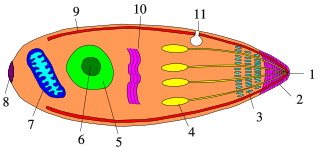Plasmodium falciparum is a unicellular protozoan parasite of humans, and the deadliest species of Plasmodium that cause malaria in humans. It is transmitted through the bite of a female Anopheles mosquito. It is responsible for roughly 50% of all malaria cases. It causes the disease's most dangerous form called falciparum malaria. It is therefore regarded as the deadliest parasite in humans, causing 435,000 deaths in 2017. It is also associated with the development of blood cancer and is classified as Group 2A carcinogen.

Plasmodium vivax is a protozoal parasite and a human pathogen. This parasite is the most frequent and widely distributed cause of recurring malaria, P. vivax is one of the five species of malaria parasites that commonly infect humans. Although it is less virulent than Plasmodium falciparum, the deadliest of the five human malaria parasites, P. vivax malaria infections can lead to severe disease and death, often due to splenomegaly. P. vivax is carried by the female Anopheles mosquito; the males do not bite.

Plasmodium ovale is a species of parasitic protozoa that causes tertian malaria in humans. It is one of several species of Plasmodium parasites that infect humans including Plasmodium falciparum and Plasmodium vivax which are responsible for most malarial infection. It is rare compared to these two parasites, and substantially less dangerous than P. falciparum.

The Haemosporida are an order of intraerythrocytic parasitic alveolates.
Plasmodium knowlesi is a primate malaria parasite commonly found in Southeast Asia. It causes malaria in long-tailed macaques, but it may also infect humans, either naturally or artificially.

Plasmodium berghei is a protozoan parasite that causes malaria in certain rodents. Originally, isolated from thicket rats in Central Africa, P. berghei is one of four Plasmodium species that have been described in African murine rodents, the others being Plasmodium chabaudi, Plasmodium vinckei, and Plasmodium yoelii. Due to its ability to infect rodents and relative ease of genetic engineering, P. berghei is a popular model organism for the study of human malaria.
Plasmodium chabaudi is a parasite of the genus Plasmodium subgenus Vinckeia. As in all Plasmodium species, P. chabaudi has both vertebrate and insect hosts. The vertebrate hosts for this parasite are rodents.
Giovanolaia is a subgenus of the genus Plasmodium created by Corradetti et al. in 1963. The parasites within this subgenus infect birds.
Novyella is a subgenus of the genus Plasmodium - all of which are parasites. The subgenus was created in 1963 by Corradetti et al.. Species in this subgenus infect birds. It unites the avian malaria parasites with small erythrocytic meronts and elongated gametocytes.
Vinckeia is a subgenus of the genus Plasmodium — all of which are parasitic alveolates. The subgenus Vinckeia was created by Cyril Garnham in 1964 to accommodate the mammalian parasites other than those infecting the primates.
Plasmodium tanzaniae is a parasite of the genus Plasmodium.
Sauramoeba is a subgenus of the genus Plasmodium, all of which are parasitic eukaryotes. The subgenus was created in 1966 by Garnham. Species in this subgenus infect reptiles.
Plasmodium pinotti is a parasite of the genus Plasmodium subgenus Giovannolaia.

Avian malaria is a parasitic disease of birds, caused by parasite species belonging to the genera Plasmodium and Hemoproteus. The disease is transmitted by a dipteran vector including mosquitoes in the case of Plasmodium parasites and biting midges for Hemoproteus. The range of symptoms and effects of the parasite on its bird hosts is very wide, from asymptomatic cases to drastic population declines due to the disease, as is the case of the Hawaiian honeycreepers. The diversity of parasites is large, as it is estimated that there are approximately as many parasites as there are species of hosts. Co-speciation and host switching events have contributed to the broad range of hosts that these parasites can infect, causing avian malaria to be a widespread global disease, found everywhere except Antarctica.
Plasmodium vinckei is a parasite of the genus Plasmodium subgenus Vinckeia.
Plasmodium lagopi is a parasite of the genus Plasmodium.

Apicomplexans, a group of intracellular parasites, have life cycle stages evolved to allow them to survive the wide variety of environments they are exposed to during their complex life cycle. Each stage in the life cycle of an apicomplexan organism is typified by a cellular variety with a distinct morphology and biochemistry.
Plasmodium odocoilei is a species of parasites, that causes malaria in white-tailed deer.






